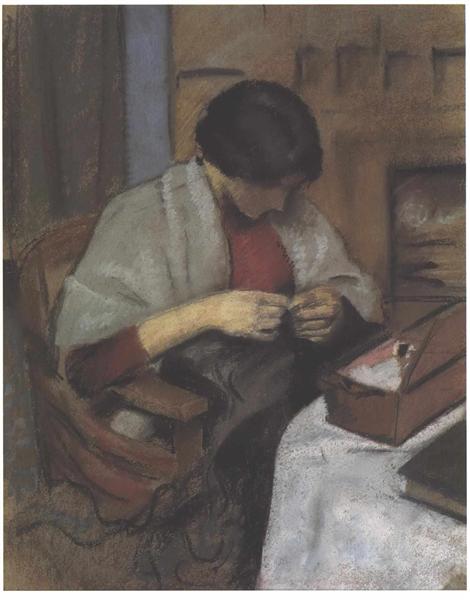Description
The work "Elisabeth Gerhard sewing" of 1909 is a fascinating example of the distinctive approach of August Macke in the representation of the human figure and everyday life through the vibrant use of color and a carefully balanced composition. This painter, closely associated with the expressionist movement and the group of artists known as Der Blaue Reiter, shows here an emotional depth and an intimate connection with the subject, which is both evocative and representative.
In the painting, the central figure of Elisabeth Gerhard occurs in a moment of serenity, deeply absorbed in her task of sewing. The composition is intriguing, since Macke uses a horizontal line that guides the view through the painting, reaffirming the sense of tranquility and concentration. The figure, with its clear tones dress, contrasts delicately with the background, which is composed of a variety of bright and cheerful colors, which enhances the feeling of intimacy. This interaction between the subject and the surrounding space is a distinctive seal of Macke's style, who frequently sought to merge the figure with the environment, creating a visual harmony that invites the viewer to share that moment.
The colors are undoubtedly one of the most shocking elements of the paint. Macke is known for his bold use of the palette; In "Elisabeth Gerhard sewing", primary and secondary tones are dynamic, infusing the work with an almost palpable energy. This color treatment not only defines shape and space, but also transmits a vibrant and optimistic mood. Loose and expressive brushstrokes contribute to the general atmosphere, suggesting a feeling of happiness and satisfaction in the performance of daily tasks.
The figure of Elisabeth Gerhard is presented with a simplicity that defies the underlying emotional complexity of the scene. His expression is serene, and his position reflects a deep connection with his work. Macke achieves, through his technique, evoke a sense of warmth and closeness to the viewer. It is impossible not to see in this work a tribute to domestic life and women of the time, whose contributions were often eclipsed by the greatest narratives in art history.
The work is not only a portrait of a woman working, but is also representative of an era of social and cultural transformation. In the context of the early twentieth century, the representation of daily activities and the approach to private life often went unnoticed in art. With "Elisabeth Gerhard sewing", Macke contributes significantly to the conversation about the representation of gender and the role of women in society.
Macke, along with his contemporaries, sought a path that would transcend the limits of academic art and his time. His exploration of light, color and form not only enriched the scope of expressionist art, but also provided a new visual language to narrate human experience. paintings Similar, such as Henri Matisse or Pierre Bonnard, share this search to capture the essence of daily life, but Macke's work stands out for its uniqueness in the way it combines the personal and the universal.
Thus, "Elisabeth Gerhard sewing" is erected as a masterpiece that not only invites aesthetic contemplation, but also encourages a reflection on the role of the individual within the vast network of everyday life. In its essence, the work of August Macke invites the viewer to look beyond the surface, find beauty in everyday and appreciate the present moment, a legacy that continues to resonate in contemporary art.
KUADROS ©, a famous paint on your wall.
Hand-made oil painting reproductions, with the quality of professional artists and the distinctive seal of KUADROS ©.
Art reproduction service with satisfaction guarantee. If you are not completely satisfied with the replica of your painting, we refund your money 100%.

